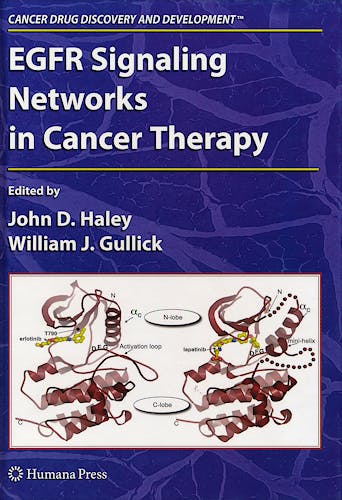

No hay productos en el carrito



EGFR Signaling Networks in Cancer Therapy (Cancer Drug Discovery and Development)
Haley, J. — Gullick, W.
1ª Edición Junio 2008
Inglés
Tapa dura
394 pags
882 gr
19 x 26 x 3 cm
ISBN 9781588299482
Editorial HUMANA PRESS
LIBRO IMPRESO
-83%
207,99 €35,00 €IVA incluido
199,99 €33,65 €IVA no incluido
Producto en Liquidación
Description
- Probes the molecular pathways and the intersection of signaling networks which are frequently deregulated in human cancers
- Describes EGF receptor in a tumor tissue specific context
- Illustrates the many ways in which EGF receptors contribute to abnormal survival and migration signaling in cancer cells and to epithelial-to-mesenchymal transition and metastasis
The epidermal growth factor (EGF) receptor and its downstream signal transduction networks have been implicated in the ontology and maintenance of tumor tissues, which has motivated the discovery and development of molecularly targeted anti-EGFR therapies. Edited by John Haley and William J. Gullick, EGFR Signaling Networks in Cancer Therapy, is separated into two sections. The first of which probes the molecular pathways and the intersection of signaling networks which are frequently deregulated in human cancers, with a view to describing EGF receptor in a tumor tissue specific context. Meanwhile, the second section illustrates the many ways in which EGF receptor contribute to abnormal survival and migration signaling in cancer cells and to epithelial to mesenchymal transition and metastasis. The book also describes the mitogenic, survival, adhesive and migratory pathways within a framework of interacting subsystems that contribute to the activity and physiological regulation of the receptor in normal and neoplastic tissues. Even though there is still much to learn, this volume explores this fascinating system with compelling information.
Reviews
"This book describes the state of EGFR antagonist development and treatment modalities…. This will be of interest to those in academic research studying EGFR signaling and/or cancer. … This is an excellent reference for those focused on a particular aspect of EGFR signaling who are looking for a concise review. This is a timely review of an increasingly complex area of study."
(James P Luyendyk, Doody’s Review Service, January, 2009)
"This book bridges the basic and clinical progress in EGFR network in cancer therapy over 40 years of EGFR research. Due to the contributors’ basic science and clinical backgrounds, the book is … best suited for basic scientists, translational scientists, and oncologists who engage in EGFR associated research and clinical therapy at various levels. The book provides a comprehensive EGFR resource for researchers not only in basic biological fields but also in preclinical and clinical therapy … ."
(Guolin Zhang and Eric B. Haura, Cancer Control, Vol. 16 (4), October, 2009)
Table of Contents
- Preface
- Scope and aims of the volume
- EGF receptor signaling: issues and challenges (W. Gullick, J. Haley)
Section I: EGFR Signaling Networks
- Chapter 1: EGF receptor family extracellular domain structures and functions (Antony Burgess, Thomas Garrett)
- Chapter 2: EGF receptor heterodimerization and activation (Howard Stern)
- Chapter 3: Structure-function of EGFR kinase domain and inhibitors (Charles Eigenbrot)
- Chapter 4: Internalization and degradation of EGF receptor (Alexander Sorkin)
- Chapter 5: Differential dependence of EGFR and ErbB2 on the molecular chaperone Hsp90 (Wanping Xu, Len Neckers)
- Chapter 6: Activation of STATs 3 and 5 through the EGFR Signaling Axisâ (Priya Koppikar, Jennifer Rubin Grandis)
- Chapter 7: The intersection of EGFR and Ras signaling pathways (Marie Wislez, Jon Kurie)
- Chapter 8: Phosphoinositide 3-kinase enzymes as downstream targets of the EGF receptor (Jan Domin)
- Chapter 9: Convergence of EGF Receptor and Src Family Signaling Networks in Cancer(Jessica E. Pritchard, Allison B. Jablonski, Sarah J. Parsons)
- Chapter 10: Molecular Crosstalk between E-cadherin and EGFR Signaling Networks (Julie Gavard, J. Silvio Gutkind)
- Chapter 11: Crosstalk between insulin-like growth factor (IGF) and epidermal growth factor (EGF) receptors (Marc Becker, Douglas Yee)
- Chapter 12: Negative regulation of signaling by the EGFR family (Kermit L. Carraway III, Lily Yen, Ellen Ingalla, Colleen Sweeney)
- Chapter 13: Nuclear ErbB receptors: Pathways and functions (Hong-Jun Liao, Graham Carpenter)
- Chapter 14: Temporal dynamics of EGF receptor signaling by quantitative proteomics (Blagoy Blagoev, Irina Kratchmarova, Jesper V. Olsen, Mathias Mann)
- Chapter 15: Computational and Mathematical Modeling of the EGFR Signaling System (Colin Johnson, Emmet McIntyre, William Gullick)
Section II: EGFR in Tumorigenesis and EGFR Tyrosine Kinase Inhibitors in Cancer Therapy
- Chapter 16: Expression and prognostic significance of EGFR in solid tumors (Nicola Normanno, Caterina Bianco, Antonella De Luca, Luigi Strizzi, Marianna Gallo, Mario Mancino, David S. Salomon)
- Chapter 17: Signalling by EGF receptor in human cancers: Accentuate the positive, eliminate the negative (Haley L. Bennett, Tilman Brummer, Paul Timpson, Kate I. Patterson, Roger J. Daly)
- Chapter 18: EGFR in invasion, metastasis and angiogenesis (Carol Box, Joanna Peak, Susanne Rogers and Suzanne Eccles)
- Chapter 19: Constitutive activation of truncated EGF receptors in glioblastoma (Carol J. Wikstrand, Darell D. Bigner)
- Chapter 20: EGFR Mutations, Other Molecular Alterations Related To Sensitivity to EGFR Inhibitors, and Molecular Testing for EGFR-Targeted Therapies in Non-Small Cell Lung Cancer (David A. Eberhard)
- Chapter 21: Crosstalk Between COX-2 and EGFR: A Potential Therapeutic Opportunity (Andrew Dannenberg, Kotha Subbaramaiah)
- Chapter 22: Cellular sensitivity to EGF receptor inhibitors (Stuart Thomson, John D. Haley, Robert Yauch)
- Chapter 23: Utilizing combinations of molecular targeted agents to sensitize tumor cells to EGFR inhibitors (Elizabeth Buck, Alexandra Eyzaguirre, Kenneth K. Iwata)
© 2025 Axón Librería S.L.
2.149.0